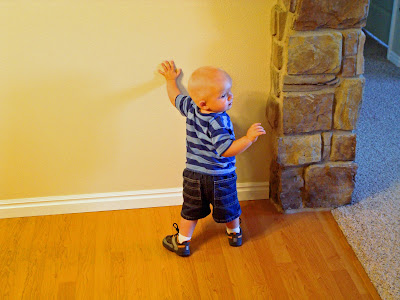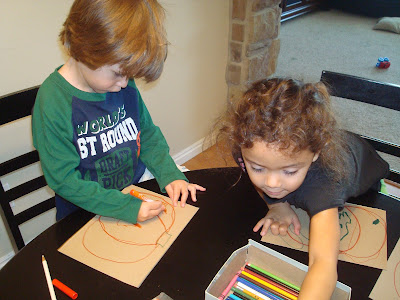This is yet another handout I recieved from Kids on the Move.
It specifies the development of motor; what comes first, how old the average child should be doing what, etc.
I like checklists such as these so parents can determine where their child is, but more importantly what they can focus on to help further their development.
Motor Development
First Steps and Beyond
Standing Balance
Child will:
- Spend a lot of time standing and playing at a chest high surface
- Stand with back support (against a couch)
- Stand facing a flat surface (fridge, wall or cabinet) so trunk is not supported.
- Stand in the middle of the room holding onto a common toy.
Cruising (9-13 months)
Child will:
- cruise at different surfaces - starting with chest high
Encourage cruising by:
- moving a toy farther away, forcing them to move to it
- shift weight at their hips to encourage leg movement
- remember to help child to cruise in both directions
Cruising Gaps
Ecourage by:
- starting with furniture together or very close to build confidence
- increase gaps as able
- set up cruising opportunities if there aren't any already (use a kitchen chair, ottoman, etc).
Walking with Support (10-12 months)
- Once child can balance, hold hands at child's side (no higher than chest).
Encourage by:
- Progressing to one handed support by having child hold a toy (for a short distance).
- Push a push toy, weight it down if needed.
- Push a chair, laundry basket or box
- Walk with an object you hold (like a hoop)
Walking Unsupported (11-13 months)
Child will:
- walk to a parent or couch and let go for the last 1-2 steps
- stand with back against the couch and then try to step forward from there
- may do better with or without shoes
Early Walking Tips (13-15 months)
- walk on different surfaces (tile, carpet, grass, cement, sand, mattress)
- walk between surfaces; if indoor use blankets, pillows, cushions, etc.
- walk wearing big shoes
Early Walking
- walk up or down small inclines or curbs
- carry light toys or pull toys on a string
Standing from the Ground Without Support (12-15 months)
Child will:
- get onto hands and feet and push up into standing
- more mature pattern is to go into a half kneel and push from the floor to stand
Encourage by:
- putting their hands on a slightly higher surface like a cushion, box or bench
Backwards and Sideways Walking (14-15 months)
Encourage by:
- playing "Ring around the Rosie" to walk sideways
- pull a toy on a string to walk backwards
- walk backwards away from getting tickled
- rearrange furniture so that you have to walk sideways to get through
- you push a box while child pulls and walks backwards
Rapid Walking/Running (14-18 months)
Encourage by:
- holding childs hand and pulling him to encourage a faster walk
- play chase
- "run" down a small incline (this encourages a rapid walk)
Walking Upstairs With One Hand Held (17-19 months)
Encourage by:
- trying to step up onto a small curb, box or stool
- showing them how to hold onto a rail or wall
- not always holding the same side
Alternating feet is not important at this stage.
Kids may lead with the opposite leg of the hand you are holding onto.
Walking Upstairs Alone (24-25 months) and Alternating Feet (30-34 months)
Encourage by:
- starting with a curb or small step stool to practice stepping up unsupported and build strength
- to alternate feet start with physical support and a lot of verbal cues
- put red and green stickers on each foot and match them to red and green cut outs you put on the stairs
Walking Downstairs with a Rail (24-26 months) and Alone (25-27 months)
Encourage by:
- starting with a curb, a few stairs or a child size stair case
- you can stand in front and hold one or both hands, remember not to show a worried face
- place childs hand on the wall so that they use it for support
Kicking a Ball (18-24 months)
- start with a large lightweight ball like a beach ball
- start by walking into a ball and then encourage kicking when standing still
- remember to use both feet
Running "Fairly Well" (18-24 months)
- arms should swing in alternate pattern with legs
- both feet are leaving the ground
- pull holding onto a hand to encourage a faster pace or chase
Climbing Onto an Adult Chair (18-21 months)
- a couch is the easiest, then a chair with arms, then a kitchen chair
- you can start by stepping onto a slightly higher surface like a bench or box or taking a cushion off
- help them raise one leg up, then hold it there
Picking Up a Toy from the Floor (19-24 months)
- start with picking up a toy from a slightly higher surface (cushion, bench, box or your hand)
- make sure the child is bending his knees to sqaut
Jumping in Place (22-30 months)
Encourage by:
- bouncing to music and encourage knee bending
- jumping on a trampoline, a mattress while holding onto the headboard, the crib holding onto a rail, or the sofa holding onto the back
- wait for child to initiate the jump and then help so that feet leave the ground
Jumping
- jump to pop bubbles, bubble wrap, or jump into or out of a hoop
- jump off of a small step, curb or box; hold hands and help both feet leave the ground if the child is stepping down
- watch "tigger" videos, sing jumping songs
Standing on Tiptoes (23-25 months) and Walking on Tiptoes (25-30 months)
Child will:
- reach up for a toy on the counter, a picture on a wall or a ball you are holding
Encourage by:
- holding hands and pulling up to encourage getting onto tiptoes
- pretend games - tiptoe past the sleeping dolls, pretend to "grow"
Walking with More Mature Gait (23-30 months)
- walk between lines that are drawn or taped on the ground (they should get as narrow as 8" apart)
- walk on a plank of wood
- walk along a long piece of toilet paper
Catching a Ball (24-26 months)
- blow bubbles and have child try and "catch" or pop those that are blown towards them (start in sitting position so balance is not an issue)
- encourage child to trap ball against body
- catch a large balloon, light beah ball or gurdy ball
- start closely placing the ball in childs hand and then move further back
Running with Control (24-30 months)
- play chase around a large obstacle in the room (chair, trash can or a tree outside)
- gradually decrease the size of the obstacle to the size of a book, increase the number of obstacles
- play "red light, green light" to stop quickly
Balancing on One Foot Briefly (24-30 months) and for 5 Seconds (30-36 months)
- stomp on bubbles or bubble wrap
- stand to put on an adult's shoe without assistance or while getting dressed
- play "Simon Says"
- kick a ball
- walk up stairs with support
- put a ladder on the floor and step over the rungs
- try to lift up a bean bag that is placed on the foot
Riding a Tricycle (32-36 months)
- find a trike that allows the child's feet to reach the pedals and has a long lever arm
- strap in feet if they do not stay on the pedals
- push the trike with feet on the pedals so that child feels how the pedals move, start on a small incline
General Motor Planning
- encourage playing in new ways so that the child has to problem solve to do the task (go to a park)
- climb over small obstacles (like the ledge into the ball pit) or onto something unstable (platform swing)
- use play equipment for combining activities like crawling in tunnels, climbing, sliding and jumping
Red Flags - When to Consult with a Physical Therapist
- neglect of one side of the body - strong favoring of one arm or leg or leading with one leg
- not pulling to stand by 11 months or walking by 17 months
- can't stand without furniture 1-2 months after walking
- up on toes more than 50% of the time
- severe in-toeing or out-toeing that doesn't correct with time
- severely "flat" feet (pronated)
- clumsiness is so severe that it effects function








































































